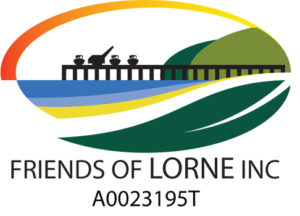
Occasional newsletter, October 2020

The Arts in Lorne & AGM
Webinar: Saturday 14 November at 4-5 PM followed by our AGM 5:15-6:00 PM
The Building of QDOS and the philosophy… behind it
Graeme Wilkie OAM
Sublime. Many of us have been missing the beauty of the amphitheatre at Qdos over the last few months. Let artist and local arts champion Graeme Wilkie take you there in this Zoom webinar. Hear how it all began and the story behind some of our most loved sculptures around Lorne.
Registration on Eventbrite here
Details of the meeting (agenda, motions and proxies) are here
If elections are needed members will be contacted again after nominations close. You can nominate yourself or another person, nominees must be financial members of the Friends of Lorne
Nominations for President, Secretary, Treasurer and Committee close Saturday 7th November. Email Committee@friendsoflorne.org.au
Serving on the Friends of Lorne Committee
Please consider volunteering to be part of the FoL Committee. We schedule eight general business meetings during the year. Occasionally, in addition, we have a special purpose meeting to respond quickly to an issue and/or discuss matters in depth. Each meeting is 1.5- 2 hours. There are two working groups leading work in specific areas, one in the environment, and the other on planning proposals. For the foreseeable future, meetings will be held via Zoom. If you need help installing and operating Zoom, we can arrange a technician to help you, free of charge.
It is a busy time for FoL, and will continue to be so while the Great Ocean Road Coast and Parks Authority is established over the coming year. We anticipate the need for community consultation and response on a range of issues.
Volunteering to be part of the FoL Committee does not just mean attending meetings – though we are grateful for that. In addition, you will need to read the electronic documents (and if necessary print them) that are circulated in advance of meetings. Some of these concern work conducted by other groups we are involved with, such as the Committee for Lorne and the Great Ocean Road Coastal Network. The reading can be a bit hefty sometimes, but vital and often of great interest. This would involve an extra half hour per meeting, on average.
Committee life sound like it’s not for you? You can still put your hand up to offer generous help in other ways. We are always keen to hear from people with media and web/tech skills for communication. Lawyers are always handy and welcome. Planners. Environmentalists. Writers. People willing to lead in particular topic areas and even dream up new ideas. Let us know what you’re thinking.
Established in 1966 and driven by a love for Lorne, FoL has a passion to ensure Lorne remains an area of special significance and natural beauty. If you are not already a member, please become one. Thanks for being a Friend of Lorne. (Recruit your neighbours!).
Applications for membership here
Renewals here
Other membership matters
Welcome to new members Mark & Bronwyn Stephens, Colin Leitch, Felicity & Peter Harkness and Mary Rose Yuncken. We look forward to you getting involved.
September bushfire webinars well attended
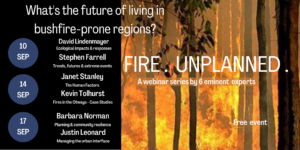
In October 2020 Friends of Lorne, working with the Aireys Inlet & District Association (AIDA), ran a series of three webinars on bushfires. This was a new and interesting (as in the apocryphal Chinese curse ‘may you live in interesting times’) exercise for us.
More than 200 people attended each webinar, and about 100 have viewed each one since they became available on the web. Thanks to those who gave us feedback.
All three sessions are now on YouTube. The links are here.
Welcome to new Councillor
We welcome Gary Allen as our new Lorne Ward Councillor for the Surf Coast Shire, following the retirement of Clive Goldsworthy in this position.
Gary’s Allen ancestors came to Lorne in 1875 as orchardists for the Mountjoy family and his Anderson ancestors came as brickmakers. The Mountjoys established Erskine House (now The Mantra).
Gary is widely known and respected as a dedicated leader who serves his community. He was principal at the Lorne P-12 school for seven years. He helped grow the membership and profile of the Lorne Historical Society, the Lorne Bowls Club and the Lorne Community Connect. More recently he has been part of the team leading an initiative by the Surf Coast Shire to create more age-friendly communities.
___________________________________________________
Fires, forests and futures
‘In 2020, Victorians ought not be surprised by bushfire. It is a constant in our landscape. Yet every time a major bushfire event occurs, it seems that many in the community are caught unawares as if by something new and unprecedented. A demand for answers, a search for what went wrong and who to blame inevitably seem to follow.’
One way or another, the bushfire buck stops with us. Any number of inquiries have come up with this finding. Put another way, we are responsible for what happens to us.
Our responsibility extends past preparing our property and our personal fire and travel plans. Although we must rely on government (Parks Vic, SCSC, CFA, DELWP) for some aspects of fire management, they act on our behalf.
This article is about evidence and values, both of which come into play in fire management, and uses the ‘strategic firebreaks’ project as the context for thinking about fire management in the broad.
‘strategic firebreaks’
What is a strategic firebreak (for a list of links to documents about the breaks click here)? In what senses do they make things better? Are they an unequivocally good thing?
Read more
Lorne will soon be almost completely surrounded by a 40 m wide strip of land containing quite a few trees but little or no undergrowth or surface litter. This is the strategic firebreak. In effect, it is a strip of forest that is being converted to grassy woodland. For those of you who are surprised about having trees in a firebreak, their presence is supported by conceptual modelling backed by experience (for more on this go to the 32:37 minute mark in webinar session 3).
No one is claiming that these breaks will protect us in extremes or from all fires. Nothing will do that. But they are expected to help fire fighters protect property in lesser burns, including planned fires (eg fuel reduction burns) that go astray. They will also make some areas more accessible for fire fighters.
For a list of firebreak maps for the whole Surf Coast click here, for Lorne only click here. The information sheet for Lorne includes an invitation to inspect work and contact addresses.
The fire authorities are also attempting to reduce the likelihood of access roads becoming impassable during fires by selectively felling trees along the Deans Marsh and Great Ocean Roads.
Fire management, a personal view
Probably most of us accept that ‘the protection of human life [in bushfires] is paramount’. What is next most important? Like Kevin Tolhurst (52 min, session 2), I have reservations about the ascendancy of property protection over environmental considerations.
I can’t find an official document that rates property ahead of environment (which is not to say one does not exist), but it’s not hard to see why property always ends up as our prime concern. Its loss is easily costed, environmental loss is not. Property loss has obvious and immediate consequences, environmental loss may not (for humans anyway). It is easier to think about property protection than to undertake the expensive and time consuming monitoring needed to understand what happens to biodiversity (4:30 min session 1). And yet Victorians cite the natural environment as being the thing we value most about the coast (for 2018 survey results click here).
If we are serious about addressing the risks fire poses for the natural environment (and human life and property), then we have to be serious about mitigating the root cause of the worsening situation.
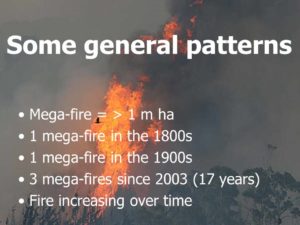
As all the webinar speakers agreed, that cause is climate change (for Lorne climate trends 28:20 min, session 1). Not only do we have to mitigate change, we also have to adapt to our situation as it is now or soon will be.
Unfortunately mitigation and adaptation do not necessarily go hand in hand. Take the firebreaks. By adding a layer of protection they go some way to counteracting the enhanced risk we are already experiencing, and in that sense they are adaptations to climate change. But their creation also reduces the amount of carbon stored in the forest and releases some of it to the atmosphere as greenhouse gases. The opposite of mitigation. In other words, and taken in isolation, dealing with the symptoms will make the disease worse.
Unless, that is, we take compensatory action. Forests can be a source of greenhouse gases or a way of capturing them from the atmosphere and storing them for the long-term. The issue of carbon capture and storage is broader than the firebreaks. It involves our forest management in totality. Has action been taken to compensate for the emissions created by the firebreaks and other fire management practices? As far as I can tell potential impacts have been pigeonholed as too small to bother with and left undefined.
Surely this judgement that small acts are inconsequential is misguided. Collectively they are undoubtedly consequential. Who is responsible for the collective effect? Is it no one? Or is it those responsible for each small act?
Wondering just how small is ‘small’, I sat down to do some back-of-the-envelope calculations to answer the question ‘how much carbon dioxide will be generated by the creation of the strategic firebreaks around Lorne?’ Four hours (and two spreadsheets) later my estimate was that the release would be the equivalent of 20,000 return trips from Lorne to Melbourne in a light vehicle. Is this insignificant? Is it more than compensated for by additional capture in other parts of the forest? I don’t think we know. No one seems to be asking this sort of question in the depth needed (an envelope will not do).
Although many aspects of bushfires are outside our control, there is also a sense in which we get what we deserve. If we just go along with what seems ‘obvious’, we will be in trouble. Severe fires are NOT most likely in old forests, long unburnt and containing lots of undergrowth and standing dead trees. They are more likely in young forests recovering from relatively recent burns (13:06 min, session1). Is the same true of old growth and mountain ash forests in the Otways? What about our other types of forest?
We have to pay attention to our own backyards, but we should also support our fire authorities and public institutions by making sure they have what they need to ask questions, gather evidence and apply findings to forest management. Why are we not hearing about post-COVID-19 jobs in environmental research and management? How can we ensure the environment gets its share of the job creation pie?
Mary Lush
Mary is a member of the committee revising an Australian forestry standard, AS4708
___________________________________________________
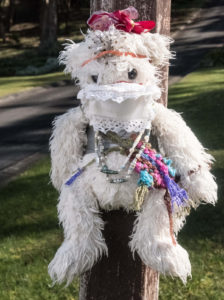
Lorne’s teddy bears
The pandemic has brought out the creativity in the Lorne. This young lady appeared in Dorman St in March. Over the weeks she has been progressively adorned by anonymous admirers.
Of course for the last couple of months she has been wearing a face mark.
Photo: Alan Shiell
___________________________________________________
Evidence-based planning for Lorne
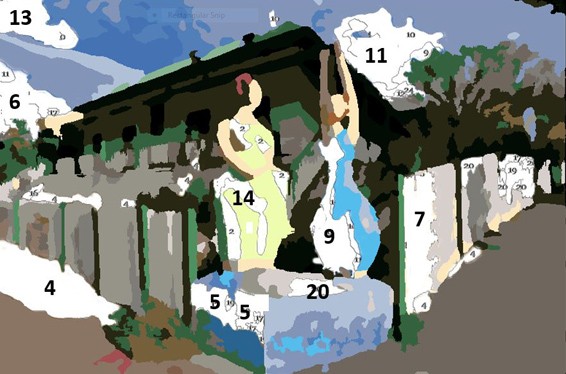
Lorne by Numbers is a whole-of-community citizen science project to build a mathematical model of how Lorne works as a town. Because Friends of Lorne are dedicated to preserving and protecting our natural environment, we need precise estimates of the costs and benefits that come from development or activity. Loose estimates or vague promises might clear more land, or build more storeys on buildings, than necessary – putting the environment and local character under threat.
The liveability and viability of the community matters. So the main goal is to identify the size and age-range of the permanent population and/or the amount of visitation per year required to keep vital community assets in Lorne e.g. CFA, SES, school, hospital, pharmacy, bank, post office, supermarket, and other desirable outcomes e.g., business viability, mobile library, and a range of sporting, recreational and cultural activities. We want to generate solutions to any problems before they arise and ‘harness’ the dynamics that keep the town strong, but still beautiful.
Right now insights about underlying patterns which make this town “tick” lie deeply within uncollated records kept by a myriad of organisations, authorities and individuals. We act like ‘data detectives’ to uncover sources of information that municipal based planners can’t put their hands on and to assemble basic analyses. The ‘heavy lifting’ work (analysis, modelling) can then be done by the Shire.
But here’s the thing. Not all development and community problem solving is about building or zoning. Lorne by Numbers is designed to help encourage reflection-and-action across Lorne in partnership with the Committee for Lorne. Sometimes an answer won’t be structural, but more social and creative. Like reaching out to encourage a diversity of volunteers. Or getting more use from existing facilities. It’s a thinking project as well as a ‘nerdy’ numbers project.
Join us! Find out more. Even if you have just a few hours to give one time only, it could make a difference. EMAIL: committee@friendsoflorne.org.au
Point Grey (pier area) UPDATE
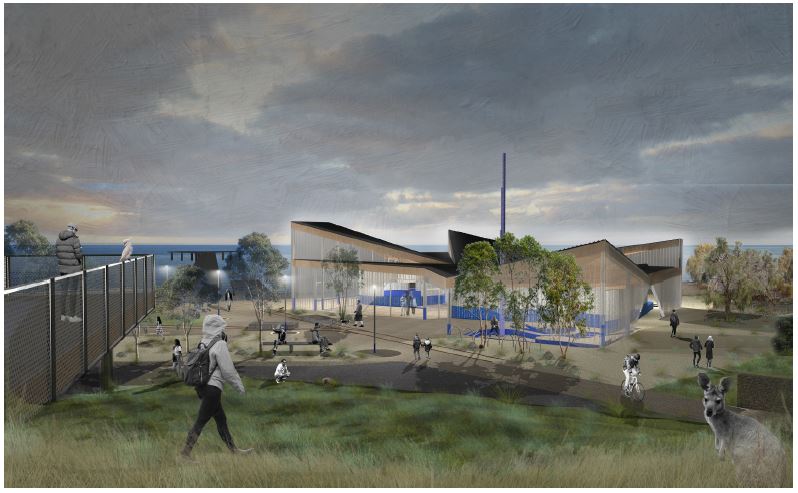
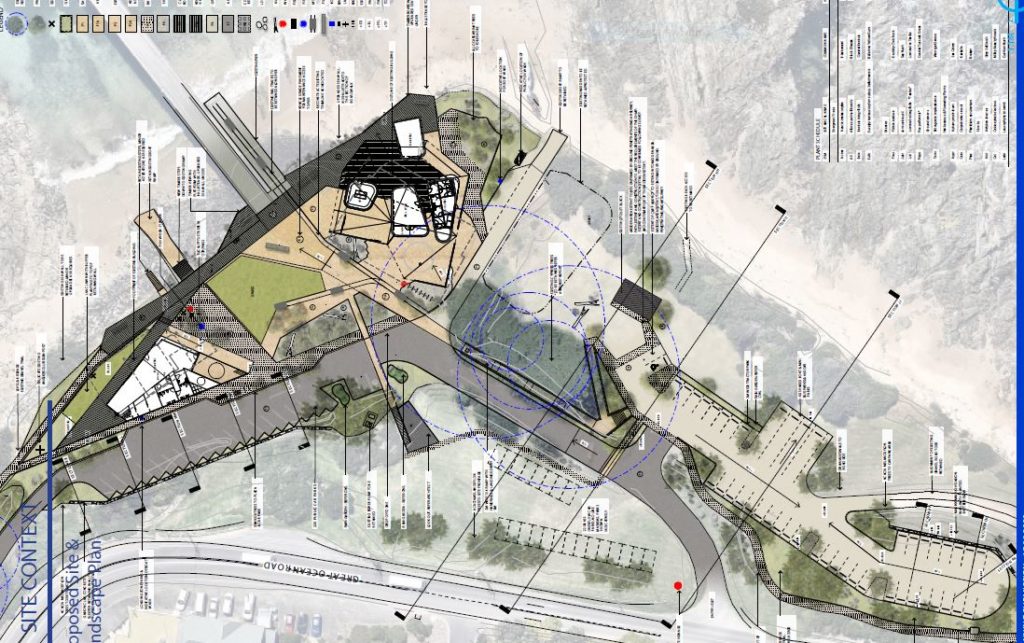
GORCC’s redevelopment plans were approved unanimously by the Surf Coast Councillors on 23 June 2020. There is to be a new aquatic club and a restaurant/event centre (a “beacon building”). But the case is being contested at VCAT.
Friends of Lorne objected to the final plans lodged with the Surf Coast in November 2019, but the Committee was divided about contesting it further at VCAT and, in the end, chose not to. We lodged our original objection to the Surf Coast Shire after GORCC failed to respond to our repeatedly raised concerns about the missing heritage element in their plans. After 16 months we still had no reply.
In our submission we also argued that an architecturally prominent, look-at-me type building is inappropriate for the largely natural site. We argued that events planned for the expanded buildings could happen elsewhere in Lorne. A copy of our objection appears on our website.
A longer article by Friends of Lorne on Pt Grey is to appear in the November issue of the Lorne Independent and will be reproduced here after publication. It explains what we want to have happen next. If you have views, contact us, please.
___________________________________________________
Natural history note, curiouser & curiouser
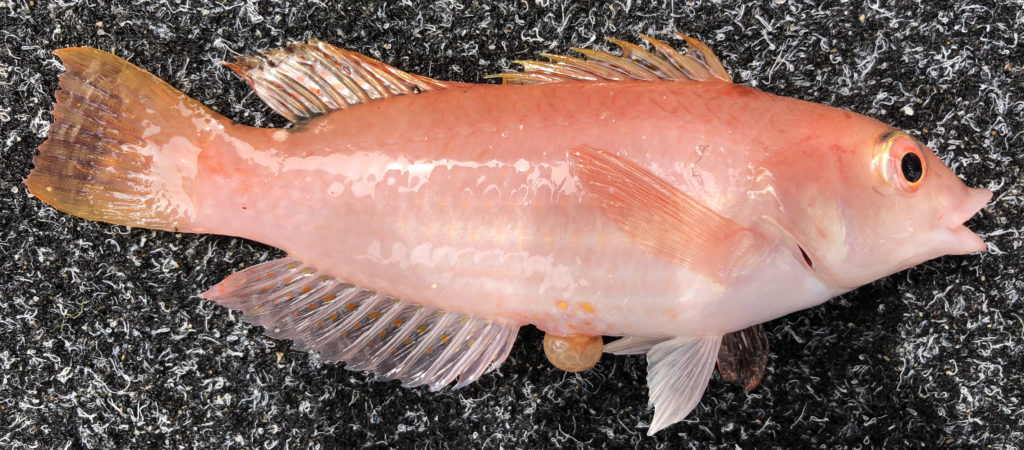
This is Rosy Wrasse (Pseudolabrus rubicundus), also known later in life as Rory Wrasse because she/he is transsexual. She starts life as a female and ends it as a male, transitioning at about mid-life and managing the feat without turning blue.
It turns out that there are hundreds of species of fish that are sequentially one sex and then the other. The Rosy Wrasse, which members of LAAC occasionally catch, is classed as a protogynous hermaphrodite. Now you know.
Mary Lush